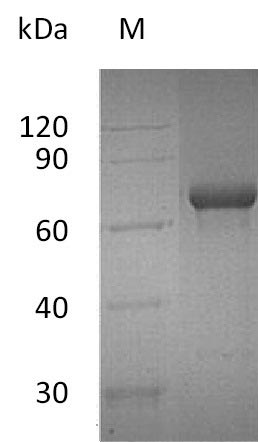Recombinant Human Tumor necrosis factor receptor superfamily member 4 (TNFRSF4) is produced in a mammalian cell expression system, covering amino acids 29-216. This partial protein is C-terminally Fc-tagged and demonstrates a purity greater than 95%, as verified by SDS-PAGE. The endotoxin level is maintained at less than 1.0 EU/µg, assessed by the LAL method. The protein exhibits biological activity, capable of binding Human OX40-Fc with demonstrated affinity constants of 70.3 nM and 165 nM in BLI assays using different biosensors.
TNFRSF4, also known as OX40, belongs to the tumor necrosis factor receptor superfamily and appears to play a critical role in immune system function. It's involved in regulating T-cell activation, promoting cell survival, proliferation, and cytokine production. Given its central role in immune responses, TNFRSF4 has become a significant focus in immunological research, particularly in studies exploring immune modulation and therapeutic interventions.
Potential Applications
Note: The applications listed below are based on what we know about this protein's biological functions, published research, and experience from experts in the field. However, we haven't fully tested all of these applications ourselves yet. We'd recommend running some preliminary tests first to make sure they work for your specific research goals.
1. OX40-OX40L Interaction Studies and Binding Kinetics Analysis
This recombinant OX40-Fc protein is confirmed to be biologically active with binding affinities of 70.3 nM (human OX40L) and 165 nM (cynomolgus OX40L), making it suitable for interaction studies. However, the C-terminal Fc tag creates an artificial dimer that may enhance avidity effects compared to monomeric membrane-bound OX40. Researchers should validate that binding kinetics reflect physiological monomeric interactions rather than avidity-enhanced dimer binding. The mammalian expression ensures proper glycosylation for authentic binding characteristics.
2. Competitive Binding Assays for OX40-Targeting Compound Screening
The protein is appropriate for screening assays, but the dimeric nature may affect compound binding stoichiometry and apparent potency. Hits should be validated against monomeric OX40 or full-length receptor in cellular assays to ensure physiological relevance. The significant affinity difference between human and cynomolgus OX40L (2.3-fold) suggests species-specific optimization is needed for cross-species studies.
3. Antibody Development and Characterization Platform
This mammalian-expressed OX40 serves as a good immunogen, but the Fc tag may dominate immune responses, reducing antibodies against OX40-specific epitopes. Antibodies may preferentially recognize the dimeric conformation. Comprehensive validation should include testing against monomeric, untagged OX40 to ensure recognition of physiological receptor forms. The confirmed cross-species binding supports antibody cross-reactivity studies.
4. Cross-Species Binding Specificity Studies
The demonstrated species-dependent affinity differences enable valid comparative studies. However, the dimeric Fc configuration may amplify affinity differences compared to monomeric interactions. Researchers should perform parallel assays with monomeric OX40 constructs to distinguish true species-specific binding differences from avidity effects. The 2.3-fold affinity difference suggests significant evolutionary divergence in OX40-OX40L interactions.
5. Protein-Protein Interaction Network Analysis
The Fc tag facilitates pull-down assays but may capture non-specific interactions through Fc receptors. While useful for initial screens, identified interactors should be validated with tag-free OX40. The dimeric nature may also promote interactions that monomeric OX40 would not engage, potentially identifying non-physiological complexes. The mammalian expression ensures proper folding for physiologically relevant interactions.
Final Recommendation & Action Plan
This mammalian-expressed human OX40 extracellular domain (29-216aa) with C-terminal Fc tag is a well-characterized reagent with confirmed species-specific binding affinities, making it particularly valuable for comparative OX40-OX40L interaction studies. However, the dimeric nature of the Fc-tagged protein requires careful experimental design and validation. For immediate use: employ the established affinity constants (70.3 nM for human OX40L; 165 nM for cynomolgus OX40L) as references for binding studies, but acknowledge that these may reflect avidity-enhanced dimer binding rather than true monomeric affinity. For compound screening, this dimeric protein may provide enhanced sensitivity for initial screens, but prioritize validation of hits with monomeric OX40 or cellular assays expressing full-length receptor. When developing antibodies, use this protein for immunization, but implement stringent screening against monomeric OX40 to avoid dimer-specific antibodies. For cross-species studies, the significant affinity difference warrants investigation of the structural basis for species specificity, but includes monomeric controls to distinguish avidity effects from genuine affinity differences. For interaction studies, the Fc tag enables efficient pull-downs but requires rigorous controls for Fc-mediated non-specific binding. The mammalian expression ensures proper glycosylation, which is crucial for OX40 function, but always validates key biological findings in cellular systems expressing full-length OX40 to ensure physiological relevance.






